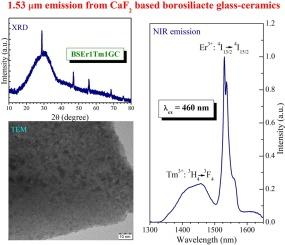Er3+/Tm3+ codoped CaF2 based oxyfluoroborosilicate glass-ceramics for fiber laser applications
IF 3.1
3区 物理与天体物理
Q2 INSTRUMENTS & INSTRUMENTATION
引用次数: 0
Abstract
Transparent Er3+/Tm3+ codoped CaF2 based oxyfluoroborosilicate glass-ceramics (BSEr1TmxGCs) with variable Tm3+ concentration were prepared through melt quench process followed by reheat treatment at 450 °C/1h. They were characterized through differential scanning calorimetry (DSC), powder X-ray diffraction (XRD), Fourier transform infrared (FTIR) Raman spectroscopy, near infrared (NIR) emission and luminescence decay. The formation of CaF2 nanocrystallites against oxyfluoroborosilicate glassy phase was confirmed by scanning electron microscopic (SEM) and hi-resolution transmission electron microscopic (HRTEM) studies. The NIR emission properties were investigated at 460 nm diode laser pumping. The applicability of BSEr1TmxGCs were examined by evaluating effective bandwidth (Δλeff), stimulated emission cross-section (σe), gain bandwidth (σe × Δλeff), figure of merit (σe × τR) and quantum efficiency (ηQE). The energy transfer efficiency (ηET), rate of energy transfer (WET) between Er3+ and Tm3+ and the rate of non-radiative transitions (WNR) were also calculated. The comparative NIR emission performance suggests that the BSEr1Tm1GC has proficiency for 1530 nm broadband fiber lasers and optical amplifiers in short wavelength and conventional wavelength (S + C) band communication window.

用于光纤激光应用的 Er3+/Tm3+ 共掺 CaF2 氧氟硼硅酸盐玻璃陶瓷
通过熔体淬火工艺制备了透明的 Er3+/Tm3+ 共掺 CaF2 氧氟硼硅酸盐玻璃陶瓷(BSEr1TmxGCs),Tm3+ 浓度可变,然后在 450 °C/1h 下重新加热处理。通过差示扫描量热法(DSC)、粉末 X 射线衍射(XRD)、傅立叶变换红外(FTIR)拉曼光谱、近红外(NIR)发射和发光衰减对它们进行了表征。扫描电子显微镜(SEM)和高分辨率透射电子显微镜(HRTEM)研究证实了氧氟硼硅玻璃相中 CaF2 纳米晶粒的形成。在 460 纳米二极管激光泵浦条件下,对近红外发射特性进行了研究。通过评估有效带宽(Δλeff)、受激发射截面(σe)、增益带宽(σe × Δλeff)、优点系数(σe × τR)和量子效率(ηQE),考察了 BSEr1TmxGCs 的适用性。此外,还计算了 Er3+ 和 Tm3+ 之间的能量传递效率 (ηET)、能量传递率 (WET) 以及非辐射跃迁率 (WNR)。近红外发射性能比较表明,BSEr1Tm1GC 可用于 1530 nm 宽带光纤激光器以及短波长和传统波长(S + C)波段通信窗口的光放大器。
本文章由计算机程序翻译,如有差异,请以英文原文为准。
求助全文
约1分钟内获得全文
求助全文
来源期刊
CiteScore
5.70
自引率
12.10%
发文量
400
审稿时长
67 days
期刊介绍:
The Journal covers the entire field of infrared physics and technology: theory, experiment, application, devices and instrumentation. Infrared'' is defined as covering the near, mid and far infrared (terahertz) regions from 0.75um (750nm) to 1mm (300GHz.) Submissions in the 300GHz to 100GHz region may be accepted at the editors discretion if their content is relevant to shorter wavelengths. Submissions must be primarily concerned with and directly relevant to this spectral region.
Its core topics can be summarized as the generation, propagation and detection, of infrared radiation; the associated optics, materials and devices; and its use in all fields of science, industry, engineering and medicine.
Infrared techniques occur in many different fields, notably spectroscopy and interferometry; material characterization and processing; atmospheric physics, astronomy and space research. Scientific aspects include lasers, quantum optics, quantum electronics, image processing and semiconductor physics. Some important applications are medical diagnostics and treatment, industrial inspection and environmental monitoring.

 求助内容:
求助内容: 应助结果提醒方式:
应助结果提醒方式:


